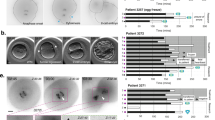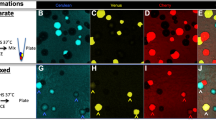Abstract
IN experiments for inducing heteroploidy in the Mammalia, it is of utmost interest to follow the chromosome picture of a treated animal through the developmental period from immediately after fertilization of the egg until adult age has been reached, or at least until sexual maturity. Beatty and Fischberg1 have described a method for obtaining mouse blastocysts for chromosome counts three and a half days after treatment of tubal eggs with cold- or hot-shock, that is, at the pre-implantation stage when the dividing cells usually contain large chromosomes. In rabbits it is most convenient to work with blastocysts at the age of 5–5½ days after copulation. At this age the diameter of the eggs is about 1–1.5 mm., but large variations are found. In older blastocysts, for example, six days old, it is often difficult to get good squash preparations due to the explosive breakup of the blastocysts, after which the different layers are difficult to spread out; although this can be done after some experience with a pair of needles. In two- to three-day old eggs, the individual cells are a little larger than from the fourth day, but the number of divisions is smaller. (This is a subjective view; no direct measurements of the cell diameter have been made.) The disadvantage in using blastocysts in studies of the chromosome number lies in the fact that it is very difficult to separate the trophoblast cells from the inner layer, and, so far as we know, nothing is known about the difference or variation in chromosome number from these different tissues. This work requires further examination.
This is a preview of subscription content, access via your institution
Access options
Subscribe to this journal
Receive 51 print issues and online access
$199.00 per year
only $3.90 per issue
Buy this article
- Purchase on Springer Link
- Instant access to full article PDF
Prices may be subject to local taxes which are calculated during checkout
Similar content being viewed by others
References
Beatty, R. A., and Fischberg, M., Nature, 163, 807 (1949).
Venge, O., Acta Zool., 31, 1 (1950).
Gay, H., and Kaufmann, B. P., Stain Technol., 25, 209 (1950).
Shzynski, B. M., J. Genet., 49, 242 (1949).
Darlington, C. D., and la Cour, L. F., “The Handling of Chromosomes” (1947).
Author information
Authors and Affiliations
Rights and permissions
About this article
Cite this article
VENGE, O. A Method for Continuous Chromosome Control of Growing Rabbits. Nature 169, 590–591 (1952). https://doi.org/10.1038/169590a0
Issue Date:
DOI: https://doi.org/10.1038/169590a0
This article is cited by
-
Chromosome constancy in the corneal epithelium of the mouse
Chromosoma (1956)
Comments
By submitting a comment you agree to abide by our Terms and Community Guidelines. If you find something abusive or that does not comply with our terms or guidelines please flag it as inappropriate.



